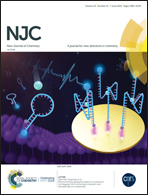Confined growth of Co–Pi co-catalyst by organic semiconductor polymer for boosting the photoelectrochemical performance of BiVO4†
Abstract
The significant recombination of carriers and low OER kinetics depress the solar to chemical energy conversion efficiency over BiVO4. The introduction of a heterostructure or co-catalyst can solve the above limitations, but it is still challenging to further understand the interaction between the heterostructure and co-catalyst in an integrated system. In this work, for the first time, we developed a strategy for the confined growth of a Co–Pi co-catalyst via bonding coordination from a polydopamine (PDA) matrix, endowing the Co–Pi co-catalyst with desirable bond anchoring and dispersion on the surface of BiVO4 (Co–Pi/PDA/BiVO4). The photocurrent density of the 0.15-Co–Pi/PDA/BiVO4 heterostructure reached up to 2.47 mA cm−2 (1.23 V vs. RHE), which is about 7 times that of bare BiVO4. The optimal charge injection efficiency increased from 25% to 75% (1.23 V vs. RHE), and an IPCE value of 27% (400 nm, 1.23 V vs. RHE) was achieved. Due to the proposed mechanism, the organic–inorganic synergistic model contributed to the enhancement in photoelectrochemical performance.



 Please wait while we load your content...
Please wait while we load your content...